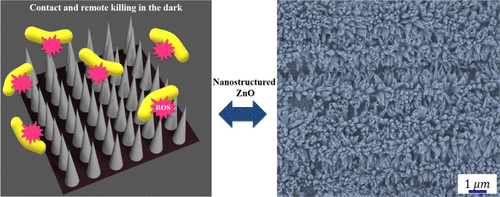当前位置:
X-MOL 学术
›
Ind. Eng. Chem. Res.
›
论文详情
Our official English website, www.x-mol.net, welcomes your
feedback! (Note: you will need to create a separate account there.)
Water-Based Scalable Methods for Self-Cleaning Antibacterial ZnO-Nanostructured Surfaces.
Industrial & Engineering Chemistry Research ( IF 3.8 ) Pub Date : 2020-07-07 , DOI: 10.1021/acs.iecr.0c01998 Athanasios Milionis 1 , Abinash Tripathy 1 , Matteo Donati 1 , Chander Shekhar Sharma 1 , Fei Pan 2 , Katharina Maniura-Weber 2 , Qun Ren 2 , Dimos Poulikakos 1
Industrial & Engineering Chemistry Research ( IF 3.8 ) Pub Date : 2020-07-07 , DOI: 10.1021/acs.iecr.0c01998 Athanasios Milionis 1 , Abinash Tripathy 1 , Matteo Donati 1 , Chander Shekhar Sharma 1 , Fei Pan 2 , Katharina Maniura-Weber 2 , Qun Ren 2 , Dimos Poulikakos 1
Affiliation

|
Bacterial colonization poses significant health risks, such as infestation of surfaces in biomedical applications and clean water unavailability. If maintaining the surrounding water clean is a target, developing surfaces with strong bactericidal action, which is facilitated by bacterial access to the surface and mixing, can be a solution. On the other hand, if sustenance of a surface free of bacteria is the goal, developing surfaces with ultralow bacterial adhesion often suffices. Here we report a facile, scalable, and environmentally benign strategy that delivers customized surfaces for these challenges. For bactericidal action, nanostructures of inherently antibacterial ZnO, through simple immersion of zinc in hot water, are fabricated. The resulting nanostructured surface exhibits extreme bactericidal effectiveness (9250 cells cm–2 h–1) that eliminates bacteria in direct contact and also remotely through the action of reactive oxygen species. Remarkably, the remote bactericidal action is achieved without the need for any illumination, otherwise required in conventional approaches. As a result, ZnO nanostructures yield outstanding water disinfection of >99.98%, in the dark, by inactivating the bacteria within 3 h. Moreover, Zn2+ released to the aqueous medium from the nanostructured ZnO surface have a concentration of 0.73 ± 0.15 ppm, markedly below the legal limit for safe drinking water (5–6 ppm). The same nanostructures, when hydrophobized (through a water-based or fluorine-free spray process), exhibit strong bacterial repulsion, thus substantially reducing bacterial adhesion. Such environmentally benign and scalable methods showcase pathways toward inhibiting surface bacterial colonization.
中文翻译:

基于水的可扩展方法,用于自清洁抗菌ZnO纳米结构表面。
细菌定殖带来重大的健康风险,例如生物医学应用中表面的侵染和清洁水的缺乏。如果要保持周围水质清洁为目标,那么可以解决这些问题,因为这些表面具有强的杀菌作用,并且可以通过细菌进入水表面并进行混合来促进杀菌作用。另一方面,如果要维持无细菌的表面是目标,那么开发具有超低细菌粘附力的表面通常就足够了。在这里,我们报告了一种灵活,可扩展且对环境有益的策略,该策略可针对这些挑战提供定制化的界面。对于杀菌作用,通过将锌简单地浸入热水中,即可制备出内在抗菌的ZnO纳米结构。所得的纳米结构表面显示出极强的杀菌效果(9250细胞厘米–2 h –1)消除了直接接触的细菌,也通过活性氧的作用消除了远程细菌。显着地,无需任何照明即可实现远距离杀菌作用,而常规方法是不需要的。结果,在黑暗中,ZnO纳米结构通过在3小时内灭活细菌,可在黑暗中产生大于99.98%的出色水消毒效果。此外,Zn 2+从纳米结构的ZnO表面释放到水介质中的浓度为0.73±0.15 ppm,明显低于安全饮用水的法定限值(5-6 ppm)。当疏水化时(通过水基或无氟喷雾工艺),相同的纳米结构表现出较强的细菌排斥力,从而大大降低了细菌粘附。这种对环境无害且可扩展的方法展示了抑制表面细菌定殖的途径。
更新日期:2020-08-12
中文翻译:

基于水的可扩展方法,用于自清洁抗菌ZnO纳米结构表面。
细菌定殖带来重大的健康风险,例如生物医学应用中表面的侵染和清洁水的缺乏。如果要保持周围水质清洁为目标,那么可以解决这些问题,因为这些表面具有强的杀菌作用,并且可以通过细菌进入水表面并进行混合来促进杀菌作用。另一方面,如果要维持无细菌的表面是目标,那么开发具有超低细菌粘附力的表面通常就足够了。在这里,我们报告了一种灵活,可扩展且对环境有益的策略,该策略可针对这些挑战提供定制化的界面。对于杀菌作用,通过将锌简单地浸入热水中,即可制备出内在抗菌的ZnO纳米结构。所得的纳米结构表面显示出极强的杀菌效果(9250细胞厘米–2 h –1)消除了直接接触的细菌,也通过活性氧的作用消除了远程细菌。显着地,无需任何照明即可实现远距离杀菌作用,而常规方法是不需要的。结果,在黑暗中,ZnO纳米结构通过在3小时内灭活细菌,可在黑暗中产生大于99.98%的出色水消毒效果。此外,Zn 2+从纳米结构的ZnO表面释放到水介质中的浓度为0.73±0.15 ppm,明显低于安全饮用水的法定限值(5-6 ppm)。当疏水化时(通过水基或无氟喷雾工艺),相同的纳米结构表现出较强的细菌排斥力,从而大大降低了细菌粘附。这种对环境无害且可扩展的方法展示了抑制表面细菌定殖的途径。











































 京公网安备 11010802027423号
京公网安备 11010802027423号